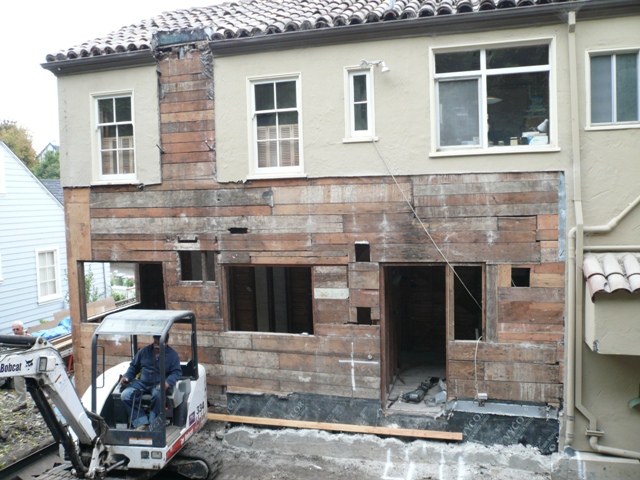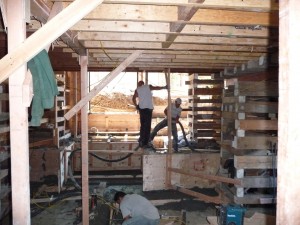
With geologists predicting a large earthquake in the coming years, now is the time to get your home properly reinforced. Photo: Paradigm Concrete & Construction, Inc. (2016)
Living in the Bay Area, we have a lot to be thankful for, from the mild, sunny weather to the lush, scenic landscape. Additionally, we’re spared from many of the severe weather phenomena that exist in other areas, such as hurricanes, blizzards and tornados. However, there’s one destructive natural force the Bay Area isn’t exempt from: earthquakes. While an earthquake may lack the portentous visual dread of a Midwestern twister, perhaps no other natural disaster is able to inflict such a devastating toll in such a brief span of time—often mere seconds. What’s worse, we’re due: Geologists predict that a large magnitude earthquake will occur in Northern California within the next 30 years, likely along the Hayward Fault.
Due to the latent risk that comes with living in a seismically active area, it’s crucial that Bay Area residents be as prepared as possible for the next “big one.” One of the most critical preparatory measures is “seismic retrofitting,” which is the application of structural reinforcements to homes and buildings. By helping structures withstand earthquake vibrations, seismic retrofitting can prevent catastrophic damage while also protecting life and limb. To gain more insight about seismic retrofitting, we’re joined by David Lorber, owner of Superior Builders & Remodelers in Oakland.
Structural Risk Factors
Everyone knows the story of the three little pigs, each of whom built his home from a different material. While the brick house ultimately withstands the Big Bad Wolf’s huffing and puffing, in an earthquake, you might actually be better off in the house built with sticks, as wood frame structures generally perform better in a seismic event than brick ones. This is good news for residents of the Bay Area, where wood frame buildings are predominant, but as Mr. Lorber explains, it doesn’t rule out the possibility of catastrophic damage. “In both the ’89 Loma Prieta earthquake and the ’94 Northridge earthquake, very few wood frame buildings collapsed completely, but we did see a good amount get shaken off of their foundations. If those buildings had been properly retrofitted, they likely wouldn’t have become total losses.”
One factor that increases a home’s likelihood of sustaining catastrophic damage during an earthquake is the presence of an open or “soft” first story, a common example of which is a home built over a garage. “When a large structure is resting on a first story with a gaping hole in the middle, it doesn’t take a structural engineer to determine this isn’t the strongest design,” says Mr. Lorber. “Buildings with soft first stories suffered tremendous damage in both the Lomo Prieta and Northridge earthquakes because there just wasn’t much to give them lateral stability. Since seismic force acts on walls much like a strong wind, if a structure’s walls don’t have good lateral stability—the strength to resist that wind-like force—they’re much more likely to fail.”
Also at higher risk are homes that have “cripple walls.” Typically less than a full story in height, these walls are used to raise a home above its foundation, especially in instances when the home isn’t on a flat lot. Cripple walls are typically the weakest part of older buildings, which is why they’re usually the first thing to fail in an earthquake.
Remedial Measures
When it comes to reinforcing against earthquake damage, every home has its own unique issues that need to be addressed. However, in general, seismic retrofitting boils down to three basic measures. The first is to anchor the structure by securing sections of wood framing to the foundation with long steel rods. This will prevent the home from sliding off of its foundation during an earthquake. Secondly, if the building has cripple walls, they need to be braced by attaching high-grade plywood to the wall framing. Walls in soft story homes also need additional reinforcement, either with strategically placed plywood bracing or, for heavier structures, an engineered steel moment frame. Finally, the home’s floor system needs to be connected to the foundation to prevent it from slipping during an earthquake.
While any home that hasn’t been retrofitted should be addressed, in some cases, homes that have already had work done may need a second look. “Foundation bolting was around even prior to Lomo Prieta, but since building permits weren’t required back then, it was often done without the involvement of a structural engineer,” explains Mr. Lorber. “Consequently, a lot of seismic work done in the ’80s and even the early ’90s is substandard. I’ve personally seen several cases where bolting was inadequate, the walls weren’t tied to the floor system, and the connections from the posts to beams and piers were ignored. So, unless your seismic work was done relatively recently, you should probably have an engineer take a look and assess the situation.”

A good way to reduce the cost of seismic retrofitting is to have it done in conjunction with a remodeling project. Photo: Alameda Structural, Inc. (2016)
Counting the Cost
Naturally, one of the first questions that comes to mind when discussing seismic retrofitting is, “How much does it cost?” According to Mr. Lorber, determining this is anything but cut-and-dry. “It really depends on how much you’re willing to invest and how secure you want to be,” he says. “It’s kind of like an insurance policy: the more you’re willing to spend, the better protection you’ll have. Typically, on an average house where no seismic work has been done, the cost of a full retrofit will fall somewhere between $25,000 and $50,000, depending on what’s needed.”
While the cost is far from insignificant, Mr. Lorber says a surefire way to minimize the expense of retrofitting is to have it done in concurrence with another building project. “Often, the price of seismic work is driven up by the need to open up walls and remove mechanical and electrical equipment. That’s why an ideal time to do retrofitting is during another building or remodeling project, because things are already opened up. Whenever I’m doing a large remodeling project, I always recommend that my clients consider making structural upgrades in the area we’re working on, because if they decide to do it later, everything has to be torn out again and it’ll cost them double.”
In any case, Mr. Lorber says the first step to making your home more earthquake-safe is to be aware of its current condition. “I always recommend having a structural engineer come out, inspect your structure and tell you the most important things that need to be done. In particular, whether you have a brick or wood frame building, you need to figure out whether it’s reinforced and see what needs to be done to make the structure more stable.”
To find a Diamond Certified building contractor in your area, visit www.diamondcertified.info.
